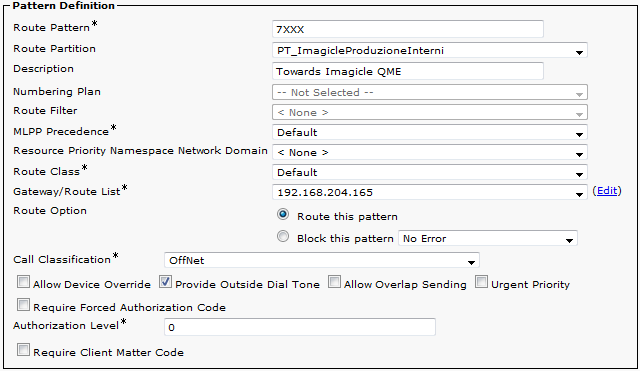Cisco UCM, WxC DI and CCME SIP Routing
Cisco Unified CallManager™ Configuration
Imagicle Auto Attendant interacts with CuCM using a SIP trunk to accept incoming call and transfer calls to any destination target.
The required configuration on the CallManager includes the following steps:
SIP Profile configuration
SIP Security profile configuration
SIP trunk configuration
Route pattern configuration
TAPI devices association (associate all the phones to the ImagicleCTI user)
1. SIP Profile
Define a new SIP Profile named Imagicle_QME_SIP_Profile, with following settings respect to the default values:
Redirect by Application: | enabled |
Option PING | enabled |
2. SIP trunk security profile
Define a new SIP trunk security profile named "Imagicle_QME_Security_Profile", with following settings different from the default values:
Incoming Transport Type | TCP + UDP |
Outgoing Transport Type | UDP |
Incoming Port | 5062 |
Enable Digest Authentication: | disabled |
Enable Application Authorization: | disabled |
Accept Out-of-Dialog REFER: | enabled |
Accept Unsolicited Notification: | enabled |
Accept Replaces Header: | enabled |
3. SIP trunk
Define a new SIP trunk named "Imagicle_QME_SIP_Trunk", with following settings different from the default values:
Device Information | |
Device pool: | A device pool containing all CUCM nodes handling incoming calls |
Call classification: | OnNet |
Retry Video Call as Audio | enabled |
Run On All Active Unified CM Nodes: | enabled |
Outbound calls | |
Redirecting Diversion Header Delivery - Outbound: | enabled |
Calling Party Selection: | Originator |
Inbound calls | |
Redirecting Diversion Header Delivery - Inbound: | enabled |
Calling Search Space: | A CSS suitable to reach AutoAtt server itself |
SIP Information | |
Destination Address: | IP address of the Imagicle server (IPv4) |
Destination Port: | 5062 |
Out of Dialog Refer CSS: | A CSS suitable to reach AutoAtt server itself |
SIP Trunk Security Profile: | Imagicle QME Security Profile |
SIP Profile: | Imagicle QME Profile |
Rerouting Calling Search Space: | A CSS suitable to reach AutoAtt server itself |
4. Route Pattern
A route pattern is needed to route incoming calls to Imagicle Auto Attendant. The route pattern pointing to Imagicle QME Trunk should be defined accordingly with the PBX numbering plan and with the IVRs phone number. For example, defining a route pattern 8XX will allow to manage IVRs with phone number 801, 802, etc..
The route patterns and the other rules used to send calls to Imagicle Auto Attendant should never change the called party number. In this way, AutoAtt can tell which calls are coming back from the operators or other IVRs.

Cisco Unified CallManager™ Express Configuration
Enter the privileged mode and in the global configuration add this command:
voice service voip
no supplementary-service sip refer
sip
rel1xx supported "rel100"Then create a dial-peer to route the calls to the IVRs. For example, if your IVRs pilot numbers begin by 9:
dial-peer voice 9000 voip
description Imagicle Auto Attendant
destination-pattern 9...
session protocol sipv2
session target ipv4:10.10.10.10:5062
dtmf-relay rtp-nte
codec g711ulaw
no vadWhere 10.10.10.10 it the Imagicle UCX Suite server IP address.
Please remember that Imagicle Auto Attendant performs outgoing calls to the operators' dn and it must reach them by placing SIP calls to the CME IP address.
Sharing same SIP Trunk with Imagicle Advanced Queuing
Please remember that both Imagicle Auto Attendant and Advanced Queuing are sharing same trunk. If you are leveraging both apps, please consult this KB for further details and configuration.
